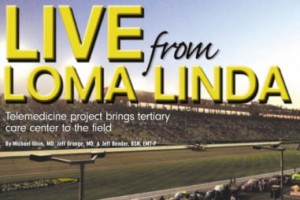11 Feb Live From Loma Linda
 More than 250,000 spectators filled the California Speedway for the NASCAR Nextel race during Labor Day weekend in 2005, making it the highest attended sporting event in California. The event itself employs thousands more, not including the race drivers and supporting teams. Because of the large crowds and predictable trauma at such locations, on-site EMS must always be at its best. However, during large-scale events, it can be difficult to determine which individuals definitely require extended services. Transports that end up being costly and unnecessary for patients may be avoided in some cases with additional resources—such as telemedicine.
More than 250,000 spectators filled the California Speedway for the NASCAR Nextel race during Labor Day weekend in 2005, making it the highest attended sporting event in California. The event itself employs thousands more, not including the race drivers and supporting teams. Because of the large crowds and predictable trauma at such locations, on-site EMS must always be at its best. However, during large-scale events, it can be difficult to determine which individuals definitely require extended services. Transports that end up being costly and unnecessary for patients may be avoided in some cases with additional resources—such as telemedicine.
Background Telemedicine has been used since the late 1980s to bring health care to individuals in remote locations. Although such obvious modalities as telephones and fax machines have been used to transmit simple documents and information, more advanced communications technology has been increasingly used to transmit photographs, video, radiographic images, ECGs and real-time examination findings (e.g., vital signs, lab results and even cardiac auscultation) from the point of current patient care to other experts across town and around the world. In a precursor to modern telemedicine, the military has used satellites to send images of patients in disaster situations, such as the 1985 Mexico City earthquake, the 1988 Armenian earthquake and the Virgin Islands in the aftermath of Hurricane Hugo in 1990.1 On a smaller scale, primary care physicians have used telemedicine to obtain specialty care consultations, such as with dermatology or otolaryngology. Other uses include providing services to extremely rural environments, prisons or long-term-care patients with diabetes or hypertension.
Read the rest of the article here

Sorry, the comment form is closed at this time.